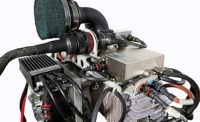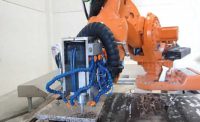Today’s typical automobile features nearly 100 exterior and interior sensors, with the number likely to increase in the near future. Those located on the outside (axle load, steering angle, blind spots, air temperature, etc.) require special protection from the elements and unique production methods.
A few years ago, the Belgian company IPTE Factory Automation n.v. developed a selective soldering machine that helps sensor manufacturers meet the latter challenge. It moves by way of a gantry handling system (from Festo Corp.) to easily access pairs of sensor batteries and PCBs within durable plastic housings, and directly connects them in less than three seconds.
Conventional soldering techniques (such as wave or reflow) are not used to solder these components because the methods produce too-high temperatures that may damage sensor housings. Instead, sensor manufacturers prefer fully automated selective soldering, which offers high process quality, accuracy and production speed. The sensor housing is designed to resist shock and corrosion, and withstand temperatures from -40 C to 100 C.
Festo’s handling system features a linear gantry with servomotors and CMMP motor controllers that control machine speed and acceleration along the X, Y, Z and W (rotation angle) axes. The system has a maximum payload of 60 kilograms.
EGC linear-axis spindle and toothed belt drives and an EGSL mini-stroke slide ensure high-speed positioning of the soldering machine along the X, Y and Z axes. For the W axis, Festo uses a customized ERMB rotary module to precisely lift and rotate the soldering needle and enable it to reach difficult-to-access locations in the housing.
Solder is uncoiled from the reel at a controlled speed and fed to an accuracy of ±0.1 millimeter. A suspension system ensures that the soldering tip is applied to the PCB with the proper force for optimum thermal contact during soldering. The system’s integrated crash sensor protects the boards against excessive pressure. Other soldering machine capabilities include automatic tip calibration, integrated tip cleaning, color detection and an option to switch to lead-free soldering.
CMMP controllers feature an EtherCat interface and allow linear and cyclic position sequences with adjustable delay times. Any number of position sets can be linked into a travel program.
All EGC drives feature an integrated displacement encoder, an exterior guide and small lever arms for high load and torque capabilities. Motors can be mounted on either side of the drive, and their positions altered at any time.
Festo offers an extensive range of ESGL slides, all of which offer precision, a dynamic response, homing options (to a fixed stop or reference switch) and the flexibility to mount a motor either axially or in parallel. Slide speed ranges from 0.5 to 1.3 mps.
Motor power on the ERMB module is transmitted to the output pinion by means of a circulating toothed belt with a specific transmission ratio. This belt is pretensioned at the factory to ensure zero backlash and keep the output shaft bearings stable.
IPTE has developed automated equipment for the production, testing and further processing of PCB assemblies and end products for more than 20 years. Its assembly solutions range from fully automated lines and inline processes with pallets that carry products, to offline processes with rotary tables or individual workstations. The company’s automation test offerings include a wide range of handlers and fixtures that perform in-circuit, functional, flashing and final tests.
For more information on gantry handling systems, call 800-993-3786 or visit www.festo.com.





